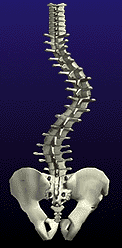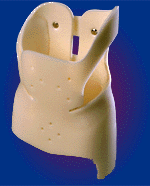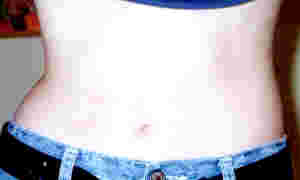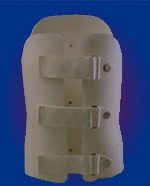
Carrie Darwin's Scoliosis Web Site

Scoliosis is defined as the condition of having an abnormal side-to-side, or lateral, curve in the spine with a degree measure greater than twenty degrees. Commonly appearing in adolescents, scoliosis can develop into a permanent, crippling disability or even death if left untreated. Early diagnosis can often result in the successful treatment* of this condition and greatly reduce the need for major surgery.
*Please note that there is no cure for scoliosis.

(The Boston brace I had to wear)
I was diagnosed with idiopathic(cause unknown) scoliosis in February, 1996, at the age of fourteen. My curve was at 36 degrees at that point. After wearing an orthopaedic brace(the Boston brace) for a year and a half, my doctors decided it was too late for the preventive measures. My idiopathic curve had grown to 45 degrees. In addition to the idiopathic curve, I was also diagnosed with a compensatory curve that was trying to compensate for my idiopathic curve. That curve stayed at 25 degrees. My torso looked twisted and my hips looked very uneven. On July 7, 1998, at LeBonheur Children's Hospital in Memphis, TN, I had an anterior spinal fusion that corrected the problem. When I woke up after the procedure, I felt like I had been hit by a bus. But, I learned that the morphine pump is a wonderful thing. :O) I stayed in the hospital 9 days. The anterior spinal fusion is a fairly new procedure where the incision is made on the side of the body. By having this procedure done instead of the posterior fusion, I did not have to have as many back muscles cut. I only have one small rod and four screws on the left side of my spine. Because the rod is on just one side of my spine, I had to wear another kind of back brace(the TLSO, which is similar to the Boston brace) for three months after my surgery. Although I hated wearing the Boston brace, I loved my TLSO. It was like having a comfort blanket. I now have one curve that is 18 degrees. I have not had any pain for several months now and I can do just about everything I could before the surgery. I would suggest the surgery to anyone.
UPDATE:
It has been a little over 4 years since my surgery. Not too long ago, I began to have problems with my left hip feeling like it was popping out of socket. I was feeling sharp pains in my neck. Also, I began having a lot of back pain and having a big problem walking at a normal pace without feeling exhausted. Worried that something was wrong with my spine, I went to my surgeon. After reviewing my x-rays and examining my back, my surgeon decided that I should start doing physical therapy exercises every day for the next 6 months. After that, I should do the exercises two or three times a week. It turns out that certain muscles became stronger than others after the surgery, and I'm facing the consequences now. My leg is not actually pulling apart from my hip, it turns out that the muscles surrounding the hip joint have become a little loose and are rubbing against my leg bone. To fix this, I'm doing regular leg exercises. It turns out I'm relying too much on my neck muscles, so I'm doing exercises to take the stress off the neck and more on all the back muscles. It's kind of hard on me now, but hopefully it will be better after I get the hang of these exercises. I hope that by me sharing this with you, somebody with similar problems will realize they need to see a physical therapist to fix their muscles. Goodluck to anyone dealing with this.

(This was taken the night before my surgery. I was standing up straight.)

(Front view of my twisted torso)


(These are pictures of TLSOs. Mine fastened in the back.)
If you would like to contact me, my ICQ # is 10689982
and my email address is carriedarwin@hotmail.com
You are
visitor number  since October 1, 2000.
since October 1, 2000.